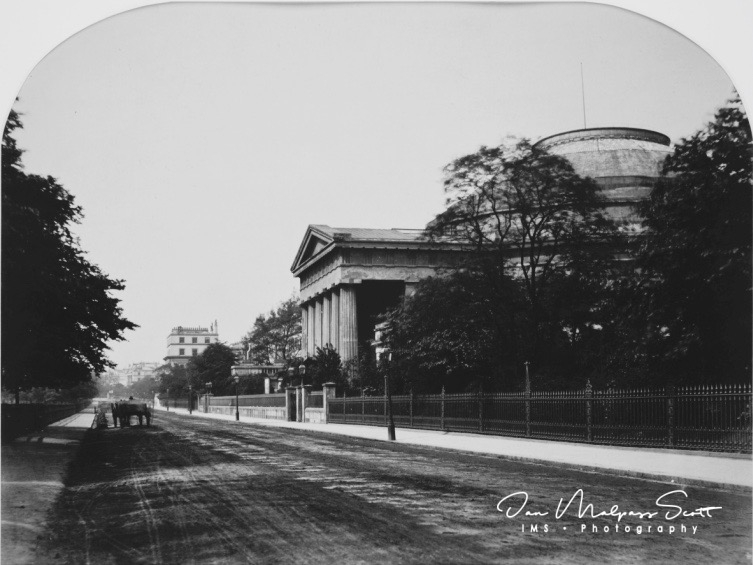
The London Colosseum was a building to the east of Regent’s Park, London. It was built in 1827 to exhibit Thomas Hornor’s “Panoramic view of London”, the largest painting ever created. The design of the Colosseum was inspired by the Pantheon in Rome. It was demolished in 1874.
History
The Colosseum was a venture of English artist and surveyor, Thomas Hornor, built to exhibit a vast panoramic view of London. The panorama was based on drawings Hornor had made from the vantage point of a temporary hut placed at the top of the dome of St Paul’s Cathedral, while the cross and ball were being replaced in 1821-2. Initial plans to sell panoramic views came to nothing, but an elaborate scheme to create a 360-degree panorama on the inside of a dome of the Colosseum, specially built in Regents Park (and resembling the Roman Pantheon rather than the Roman Colosseum), came to fruition, but at such expense that its principal backer, Rowland Stephenson MP, had to flee to America in 1828, soon followed by Hornor.
The Colosseum was built on the east side of Regent’s Park, between Chester Terrace and Cambridge Terrace. Designed by Decimus Burton, it was in the form of a sixteen-sided domed polygon, with a Doric portico. It was built of brick rendered with cement in imitation of stone.
Creation of the panorama
On 12 December 1825, E. T. Parris started work on the panorama, which was based on Hornor’s own drawings from the upper part of St. Paul’s Cathedral. The project would involve great artistic as well as technical and mechanical challenges for the artist.
By means of squares, Parris began to draw the outlines in chalk, on a scale 16-times larger each way, or, in other words, 256-times the area of the original drawings. This was a work of much labour, and demanding close attention; but it was, nevertheless, completed by the following April. The painting in oil) was then started. Hornor engaged several artists to assist Parris in the undertaking, but progress was slow and unsatisfactory due to their unfamiliarity with the type of work required. There were also problems of consistency of colour, composition etc.,and on several occasions it was necessary to repaint sections. Eventually, Parris decided to take charge and do the whole thing himself with the assistance of several house-painters; this proved to be the right choice.[
In addition to the problem of the sheer volume of the canvas, there was also the difficulty of access. This is where Parris’s mechanical ingenuity came into its own; he devised all kinds of light scaffoldings, bridges, and platforms. Sometimes he was supported from the floor by two or three long and slender spars, which vibrated with every motion of his arm; sometimes he was suspended by cords from the roof. On two occasions Parris fell from a considerable height; fortunately, in neither case did he suffer any serious injury.
The panorama was completed in November 1829, after a period of 4 years. The painting was the largest ever created, totalling over forty thousand square feet in area, and a testament to Parris’s great artistic skill, talent, and perseverance.
Built: 1824
Demolished: 1875
Architect: Decimus Burton


